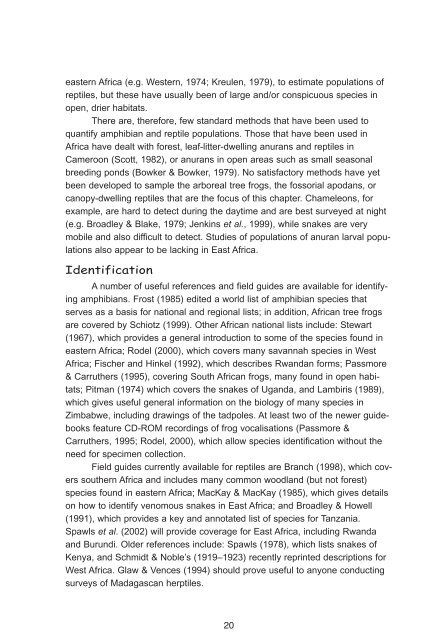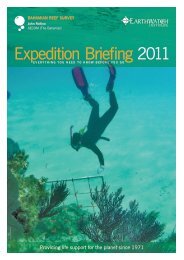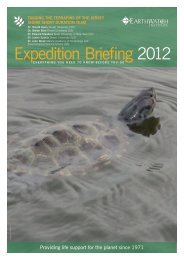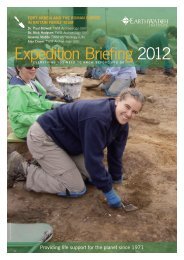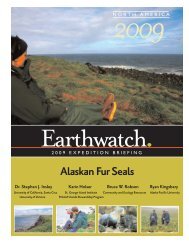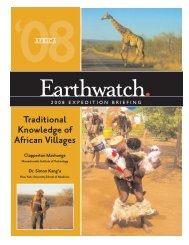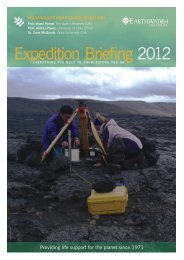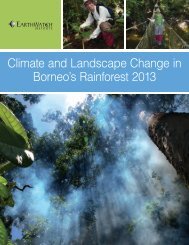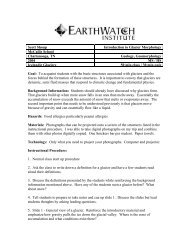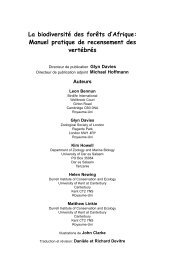African Forest Biodiversity - Earthwatch Institute
African Forest Biodiversity - Earthwatch Institute
African Forest Biodiversity - Earthwatch Institute
Create successful ePaper yourself
Turn your PDF publications into a flip-book with our unique Google optimized e-Paper software.
eastern Africa (e.g. Western, 1974; Kreulen, 1979), to estimate populations of<br />
reptiles, but these have usually been of large and/or conspicuous species in<br />
open, drier habitats.<br />
There are, therefore, few standard methods that have been used to<br />
quantify amphibian and reptile populations. Those that have been used in<br />
Africa have dealt with forest, leaf-litter-dwelling anurans and reptiles in<br />
Cameroon (Scott, 1982), or anurans in open areas such as small seasonal<br />
breeding ponds (Bowker & Bowker, 1979). No satisfactory methods have yet<br />
been developed to sample the arboreal tree frogs, the fossorial apodans, or<br />
canopy-dwelling reptiles that are the focus of this chapter. Chameleons, for<br />
example, are hard to detect during the daytime and are best surveyed at night<br />
(e.g. Broadley & Blake, 1979; Jenkins et al., 1999), while snakes are very<br />
mobile and also difficult to detect. Studies of populations of anuran larval populations<br />
also appear to be lacking in East Africa.<br />
Identification<br />
A number of useful references and field guides are available for identifying<br />
amphibians. Frost (1985) edited a world list of amphibian species that<br />
serves as a basis for national and regional lists; in addition, <strong>African</strong> tree frogs<br />
are covered by Schiotz (1999). Other <strong>African</strong> national lists include: Stewart<br />
(1967), which provides a general introduction to some of the species found in<br />
eastern Africa; Rodel (2000), which covers many savannah species in West<br />
Africa; Fischer and Hinkel (1992), which describes Rwandan forms; Passmore<br />
& Carruthers (1995), covering South <strong>African</strong> frogs, many found in open habitats;<br />
Pitman (1974) which covers the snakes of Uganda, and Lambiris (1989),<br />
which gives useful general information on the biology of many species in<br />
Zimbabwe, including drawings of the tadpoles. At least two of the newer guidebooks<br />
feature CD-ROM recordings of frog vocalisations (Passmore &<br />
Carruthers, 1995; Rodel, 2000), which allow species identification without the<br />
need for specimen collection.<br />
Field guides currently available for reptiles are Branch (1998), which covers<br />
southern Africa and includes many common woodland (but not forest)<br />
species found in eastern Africa; MacKay & MacKay (1985), which gives details<br />
on how to identify venomous snakes in East Africa; and Broadley & Howell<br />
(1991), which provides a key and annotated list of species for Tanzania.<br />
Spawls et al. (2002) will provide coverage for East Africa, including Rwanda<br />
and Burundi. Older references include: Spawls (1978), which lists snakes of<br />
Kenya, and Schmidt & Noble’s (1919–1923) recently reprinted descriptions for<br />
West Africa. Glaw & Vences (1994) should prove useful to anyone conducting<br />
surveys of Madagascan herptiles.<br />
20


